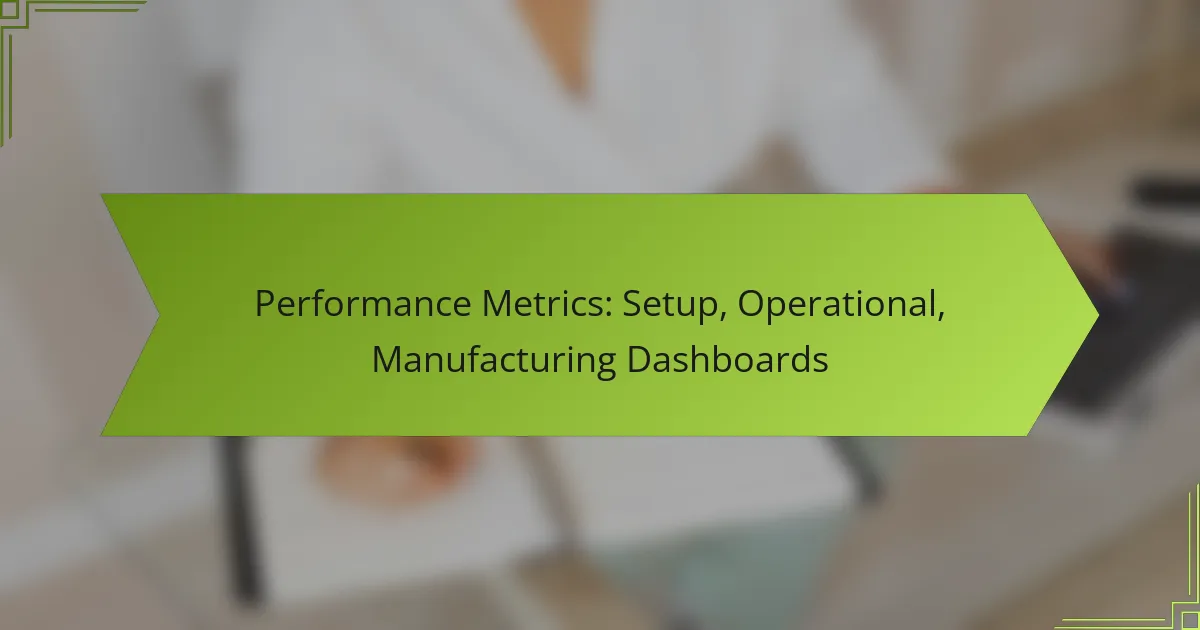Performance metrics are essential for creating effective dashboards that monitor operational efficiency, production output, quality control, and more. By setting up these dashboards with clear objectives and relevant data, organizations can gain valuable insights into their manufacturing processes, enabling informed decision-making. Utilizing advanced tools like Tableau and Power BI further enhances the ability to visualize and analyze performance metrics in real-time.

What are the key performance metrics for dashboards?
Key performance metrics for dashboards include operational efficiency, production output, quality control, cost management, and employee productivity. These metrics provide critical insights into the performance and effectiveness of manufacturing processes, helping organizations make informed decisions.
Operational efficiency
Operational efficiency measures how well a company utilizes its resources to produce goods. It is often expressed as a ratio of output to input, indicating how effectively operations convert resources into finished products.
To improve operational efficiency, companies can implement lean manufacturing principles, streamline processes, and reduce waste. Regularly reviewing performance data can help identify bottlenecks and areas for improvement.
Production output
Production output refers to the total quantity of goods produced within a specific timeframe. This metric helps organizations gauge their manufacturing capabilities and meet market demand.
Tracking production output can involve measuring daily, weekly, or monthly totals. Companies should aim for a balance between maximizing output and maintaining quality standards to avoid overproduction and excess inventory.
Quality control
Quality control ensures that products meet specific standards and specifications. Effective quality control processes help minimize defects and enhance customer satisfaction.
Implementing regular inspections, testing, and feedback loops can improve quality control. Utilizing statistical process control (SPC) techniques can also help identify trends and prevent issues before they escalate.
Cost management
Cost management involves monitoring and controlling expenses associated with production. This metric is crucial for maintaining profitability and competitive pricing.
To manage costs effectively, companies should analyze direct and indirect expenses, including labor, materials, and overhead. Regular budgeting and forecasting can help identify cost-saving opportunities and ensure financial health.
Employee productivity
Employee productivity measures the output generated by workers within a given period. High productivity levels often correlate with efficient operations and effective workforce management.
To enhance employee productivity, organizations can invest in training, provide the right tools and resources, and foster a positive work environment. Setting clear performance goals and offering incentives can also motivate employees to perform at their best.

How to set up performance dashboards?
Setting up performance dashboards involves defining clear objectives, selecting key metrics, choosing appropriate software, and integrating relevant data sources. This structured approach ensures that the dashboards effectively track and visualize performance metrics relevant to your operational or manufacturing goals.
Define objectives
Defining objectives is the first step in creating effective performance dashboards. Clearly articulated goals guide the selection of metrics and the overall design of the dashboard. For instance, objectives may include improving production efficiency, reducing downtime, or enhancing quality control.
Consider using the SMART criteria—Specific, Measurable, Achievable, Relevant, and Time-bound—to refine your objectives. This clarity helps stakeholders understand what success looks like and aligns everyone towards common targets.
Select key metrics
Selecting key metrics is crucial for measuring progress towards your defined objectives. Focus on metrics that provide actionable insights, such as production output, defect rates, or cycle times. Aim for a balance between leading indicators (predictive) and lagging indicators (historical) to get a comprehensive view of performance.
Limit the number of metrics to avoid overwhelming users. A range of 5-10 key metrics is often effective, ensuring that the dashboard remains focused and easy to interpret. Regularly review and adjust these metrics as objectives evolve or as new insights are gained.
Choose dashboard software
Choosing the right dashboard software is essential for effective data visualization and user engagement. Look for tools that offer flexibility, ease of use, and integration capabilities with your existing systems. Popular options include Tableau, Power BI, and Google Data Studio, each with unique strengths.
Consider factors such as cost, scalability, and user support when selecting software. Many platforms offer free trials, allowing you to test functionality before committing. Ensure the software can accommodate your data sources and provide real-time updates if necessary.
Integrate data sources
Integrating data sources is vital for ensuring that your performance dashboards reflect accurate and timely information. Identify all relevant data sources, such as ERP systems, CRM platforms, or IoT devices, and establish connections to pull data seamlessly into your dashboard.
Utilize APIs or data connectors provided by your dashboard software to facilitate integration. Regularly verify data accuracy and consistency, as discrepancies can lead to misguided decisions. Consider setting up automated data refresh schedules to keep your dashboard current and relevant.

What are the best tools for manufacturing dashboards?
The best tools for manufacturing dashboards include Tableau, Power BI, QlikView, and Google Data Studio. These platforms enable manufacturers to visualize data effectively, track performance metrics, and make informed decisions based on real-time insights.
Tableau
Tableau is a powerful data visualization tool that allows manufacturers to create interactive dashboards with ease. Its drag-and-drop interface simplifies the process of connecting to various data sources, making it accessible for users with varying technical skills.
One of Tableau’s strengths is its ability to handle large datasets efficiently, which is crucial in manufacturing environments where data volume can be substantial. Users can customize visualizations to highlight key performance indicators (KPIs) relevant to their operations.
Power BI
Power BI, developed by Microsoft, integrates seamlessly with other Microsoft products, making it a popular choice for organizations already using the Microsoft ecosystem. It offers robust data modeling capabilities and a variety of visualization options tailored for manufacturing metrics.
This tool supports real-time data updates, allowing manufacturers to monitor their operations continuously. Power BI’s affordability and user-friendly interface make it suitable for small to medium-sized manufacturers looking to enhance their data analysis capabilities.
QlikView
QlikView is known for its associative data model, which allows users to explore data freely without being restricted by predefined queries. This flexibility is beneficial for manufacturers who need to analyze complex datasets and uncover insights quickly.
Its in-memory processing enables fast data retrieval, making it suitable for real-time analytics. However, QlikView may require a steeper learning curve compared to other tools, so organizations should consider training for their teams to maximize its potential.
Google Data Studio
Google Data Studio is a free tool that allows manufacturers to create customizable dashboards using data from various Google services and other sources. Its collaborative features enable teams to work together in real-time, enhancing communication and decision-making.
While it may not offer the same depth of features as paid tools, Google Data Studio is ideal for smaller manufacturers or those just starting with data visualization. Its ease of use and integration with Google Analytics can provide valuable insights into operational performance without significant investment.

How to analyze operational performance?
Analyzing operational performance involves assessing various metrics to understand efficiency and effectiveness. This process helps identify areas for improvement and informs decision-making to enhance overall productivity.
Data visualization techniques
Data visualization techniques are essential for interpreting operational performance metrics effectively. Tools like dashboards, charts, and graphs can present complex data in a clear and accessible manner, allowing stakeholders to quickly grasp insights. Common visualizations include bar charts for comparing metrics and line graphs for tracking performance over time.
When implementing data visualization, focus on clarity and relevance. Use color coding to highlight key performance indicators (KPIs) and ensure that the visuals are easy to understand at a glance. Avoid cluttering the dashboard with unnecessary information, which can obscure critical insights.
Benchmarking against industry standards
Benchmarking against industry standards involves comparing your operational performance metrics to those of similar organizations. This practice helps identify gaps in performance and sets realistic targets for improvement. Industry reports and databases can provide valuable benchmarks for comparison.
To effectively benchmark, select relevant KPIs that align with your operational goals. For instance, if your industry standard for production efficiency is around 80%, aim to meet or exceed this figure. Regularly update your benchmarks to reflect changes in the industry and ensure continuous improvement.
Trend analysis
Trend analysis examines performance metrics over time to identify patterns and shifts in operational efficiency. By analyzing trends, organizations can anticipate potential issues and make proactive adjustments. This method often involves reviewing data across multiple periods, such as monthly or quarterly, to spot significant changes.
When conducting trend analysis, focus on key metrics that impact your operations, such as production rates or downtime. Use moving averages to smooth out fluctuations and highlight underlying trends. Be cautious of overreacting to short-term variations; instead, look for consistent patterns before making strategic decisions.

What are the benefits of using dashboards in manufacturing?
Dashboards in manufacturing provide real-time insights into performance metrics, helping managers make informed decisions quickly. They consolidate data from various sources, enabling better visibility and control over operations.
Improved Decision-Making
Dashboards enhance decision-making by presenting critical data in an easily digestible format. Managers can quickly identify trends, monitor key performance indicators (KPIs), and respond to issues as they arise. For instance, a dashboard may highlight a sudden drop in production efficiency, prompting immediate investigation.
Increased Efficiency
Using dashboards can significantly boost operational efficiency by streamlining data access and analysis. With real-time updates, teams can track production processes and identify bottlenecks without delay. This proactive approach allows for timely adjustments, reducing downtime and optimizing resource allocation.
Enhanced Communication
Dashboards facilitate better communication across departments by providing a common platform for data sharing. When everyone has access to the same information, it fosters collaboration and aligns goals. For example, a production dashboard can be shared with both manufacturing and sales teams to ensure everyone is aware of inventory levels and production schedules.
Performance Tracking
Dashboards enable continuous performance tracking, allowing manufacturers to measure progress against targets. By visualizing data trends over time, organizations can assess the effectiveness of their strategies. Regularly reviewing dashboard metrics can help identify areas for improvement and inform future planning.
Cost Reduction
Implementing dashboards can lead to cost reductions by minimizing waste and optimizing processes. By analyzing data on production efficiency and resource usage, manufacturers can identify cost-saving opportunities. For instance, a dashboard might reveal excessive material usage, prompting a review of supply chain practices.
